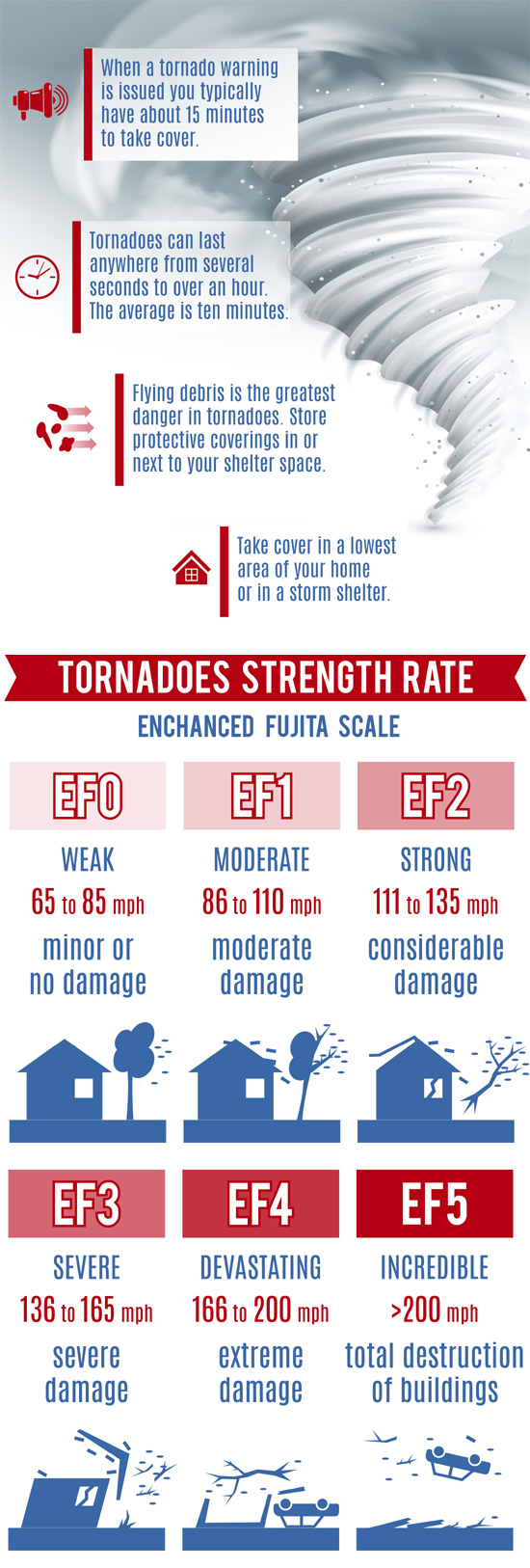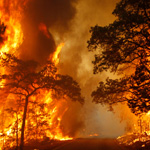Tornados
Tornados are one of the most violent atmospheric storms someone can experience. It's a rotating column of air that's in contact with the earth's surface and a cumulonimbus cloud, or in rare cases, the base of a cumulus cloud.
Also called twisters or whirlwinds, they come in several varieties. They can take the shape of a rope, cone or wedge. When several spouts spin together, they're called multi-vortex or satellite. When they're over the water, they're a waterspout.
What makes them so dangerous is how quickly they can appear and how intense the winds can be. The majority of tornados are just 250 feet across, have a wind speed of less than 110 miles per hour and travel just a few miles before dissipating. But extreme tornados are another story. They can be as large as 2 miles in diameter, have wind speeds exceeding 300 miles per hour and travel for dozens of miles.
The United States has more tornados annually than any other country, with about 1,200 a year. The invention of Doppler Radar has made them much easier to spot and predict than in the past. But just spotting them isn't enough. You have to protect people in their path.
From 1995 to 2019, less than 50 people typically would lose their lives each year in the United States from tornados. But there are exceptions. In 2008, during the Super Tuesday outbreak, 87 tornados over 15 hours appeared and killed 57 people. The spring of 2011 was even worse. Between April 25 and 28, there were 362 confirmed tornadoes which caused around $11 billion in damages and killed 321 people. Here's what you need to know that could save your life.
Enhanced F Scale for Tornado Damage
| FUJITA SCALE | DERIVED EF SCALE | OPERATIONAL EF SCALE | ||||
| F Number | Fastest 1/4-mile (mph) |
3 Second Gust (mph) | EF Number | 3 Second Gust (mph) | EF Number | 3 Second Gust (mph) |
| 0 | 40-72 |
45-78 | 0 | 65-85 | 0 | 65-85 |
| 1 | 73-112 |
79-117 | 1 | 86-109 | 1 | 86-110 |
| 2 | 113-157 |
118-161 | 2 | 110-137 | 2 | 111-135 |
| 3 | 158-207 |
162-209 | 3 | 138-167 | 3 | 136-165 |
| 4 | 208-260 |
210-261 | 4 | 168-199 | 4 | 166-200 |
| 5 | 261-318 |
262-317 | 5 | 200-234 | 5 | Over 200 |
*** IMPORTANT NOTE ABOUT ENHANCED F-SCALE WINDS: The Enhanced F-scale still is a set of wind estimates (not measurements) based on damage. Its uses three-second gusts estimated at the point of damage based on a judgment of 8 levels of damage to the 28 indicators listed below. These estimates vary with height and exposure. Important: The 3 second gust is not the same wind as in standard surface observations. Standard measurements are taken by weather stations in open exposures, using a directly measured, "one minute mile" speed.
Information Provided by National Oceanic and Atmospheric Administration NOAA.

Tornado Damage Countdown: EF0 to EF5
Enhanced F Scale Damage Indicators
| NUMBER (Details Linked) | DAMAGE INDICATOR | ABBREVIATION |
| 1 | Small barns, farm outbuildings | SBO |
| 2 | One- or two-family residences | FR12 |
| 3 | Single-wide mobile home (MHSW) | MHSW |
| 4 | Double-wide mobile home | MHDW |
| 5 | Apt, condo, townhouse (3 stories or less) | ACT |
| 6 | Motel | M |
| 7 | Masonry apt. or motel | MAM |
| 8 | Small retail bldg. (fast food) | SRB |
| 9 | Small professional (doctor office, branch bank) | SPB |
| 10 | Strip mall | SM |
| 11 | Large shopping mall | LSM |
| 12 | Large, isolated ("big box") retail bldg. | LIRB |
| 13 | Automobile showroom | ASR |
| 14 | Automotive service building | ASB |
| 15 | School - 1-story elementary (interior or exterior halls) | ES |
| 16 | School - jr. or sr. high school | JHSH |
| 17 | Low-rise (1-4 story) bldg. | LRB |
| 18 | Mid-rise (5-20 story) bldg. | MRB |
| 19 | High-rise (over 20 stories) | HRB |
| 20 | Institutional bldg. (hospital, govt. or university) | IB |
| 21 | Metal building system | MBS |
| 22 | Service station canopy | SSC |
| 23 | Warehouse (tilt-up walls or heavy timber) | WHB |
| 24 | Transmission line tower | TLT |
| 25 | Free-standing tower | FST |
| 26 | Free standing pole (light, flag, luminary) | FSP |
| 27 | Tree - hardwood | TH |
| 28 | Tree - softwood | TS |
Information Provided by National Oceanic and Atmospheric Administration NOAA.
Tornadoes 101 | National Geographic
Tornadoes are some of the most destructive forces of nature. Learn how tornadoes form, how they are rated, and the country where the most intense tornadoes occur.
The Anatomy of the Life of a Supercell
Past and Present Threats
Tornados have been spotted in every state and during every month of the year. However, they’re most commonly seen during early spring in the states along the Gulf of Mexico. They follow the jet stream and move farther north later in the summer. The most active time of day is in the late afternoon, once the sun has heated both the ground and atmosphere enough to create thunderstorms.
You’re most likely to see a tornado in “Tornado Alley.” That's a geographic region that includes the eastern part of South Dakota, Nebraska, Kansas, Oklahoma, northern Texas and eastern Colorado. Follow the information below for your best chance at surviving if you encounter one.
Preparation - Survival
What is the difference between a Tornado WATCH and a Tornado WARNING?
-
A Tornado WATCH is issued by the NOAA Storm Prediction Center meteorologists who watch the weather 24/7 across the entire U.S. for weather conditions that are favorable for tornadoes and severe weather. A watch can cover parts of a state or several states. Watch and prepare for severe weather and stay tuned to NOAA Weather Radio to know when warnings are issued.
A Tornado WARNING is issued by your local NOAA National Weather Service Forecast Office meteorologists who watch the weather 24/7 over a designated area. This means a tornado has been reported by spotters or indicated by radar and there is a serious threat to life and property to those in the path of the tornado. A tornado warning indicates that you should ACT NOW to find safe shelter! A warning can cover parts of counties or several counties in the path of danger.
Click Here for information on what to do from the United States government website, Ready.gov.
Click Here for the Red Cross Tornado Safety Information.
Click Here for the Disaster Safety information on Tornadoes from the Insurance Institute for Business & Home Safety.
Click Here to download a PDF file with information on what to do from the United States government website, Ready.gov.
Return to 101 Ways to Die Home Page
This information is presented to make people aware of the larger world around them. If you can prepare for something as devastating as this, you're much more likely to be ready for smaller disruptions. Be aware and prepare.
6/6/2020
Updated 4/15/2021
Updated 6/17/2021



